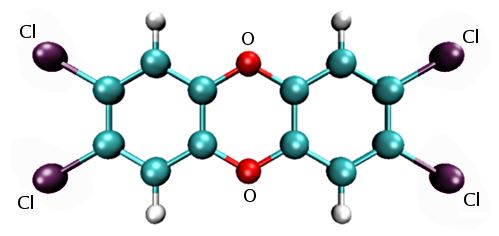The term dioxins, if not its implications, is fast becoming a household name, as it is emblazoned on the back of all state transport buses. “Say no to Plastics” is the message, as dioxins are released on burning discarded plastic items. What is it that makes dioxins so dreaded and what, if any, is the mechanism to control its emission?
In 1971 the US military indulged in copious aerial spraying of Agent Orange over Vietnam, with the objective of destroying forest cover and bringing the enemy into the open. This pernicious chemical has since bequeathed a heritage of deformed children, low IQ and spontaneous abortions on the people of Vietnam. If Agent Orange was the perpetrator of the original horror there are many others competing zealously to gain that dubious honour for themselves today. These players are to be found all over the world and have made their own sizable contribution to increasing the dioxin load in the global environment. Incineration and particularly burning of trash have been identified as the main source of dioxin in the air, which is then absorbed into the soil and water.
What are they and what do they do?
Dioxins are dreaded chemicals formed as byproducts of any process where chlorinated compounds are burned. They are extremely long lived and are present in the air, soil and water by attachment to other particles, runoff and erosion. Being fat soluble, they have entered the food chain and are present in fish (particularly the fatty variety), meats and dairy products.
Dioxins are carcinogenic and are also related to a variety of health problems like diabetes, irregular development of the immune system, liver damage, cardiovascular degeneration and much more.

In 1998 the World Health Organisation declared the tolerable daily intake of dioxins to be 1 – 4 pg/ kg (picogrammes per kilogramme bodyweight), though nobody knows actually how much dioxin can be tolerated before health problems occur. Dioxin intake of children is probably more than adults due to greater consumption of milk and dairy products while adults who partake of a diet predominant in animal meats are also at risk.
Where do they come from?
Every time any form of chlorinated waste is burned, dioxins are released. It is not hard to pinpoint a number of processes which involve the use and disposal of chlorinated substances. In fact, all or nearly all the major chemical industries involve chlorinated substances as reactants, products or by products. During all these processes dioxins will undoubtedly be released. To name a few, incineration, burning waste, bleaching of paper, production of PVC (polyvinyl chloride) plastics and chlorinated pesticides, automobile exhaust and even smelting of copper. Whether in the home, office, factory, hospital or even the farm we have welcomed products made of PVC in all their multihued splendour attribute to chlorinated dyes with open arms. So we can safely conclude that there is not a single sphere / activity of life which does not use / dispose PVCs and their manufacture and subsequent recycling or disposal by incineration are all processes which belch out clouds of toxic dioxins into the air.
How can we contain/combat dioxins?
What steps has the Government taken in India to contain the emission of dioxins? So far nothing. Not even the banning of all the 12 POPs (persistent organic pollutants) of which dioxins, furans, DDT and PCBs still proliferate in India. No study has been conducted to assess the level of dioxin to which the people are being exposed. Though India follows the EPA guidelines for dioxin emissions, there are no monitoring exercises to check for the adherence to the same. The per capita use and disposal of PVC has increased from 1.7 kg in 1997 to 4 kg in 2000. Though incineration of PVC has been banned, hospital and municipal waste containing PVC continues to be incinerated. Possible reasons are inability to differentiation between PVC and non-PVC items and the lack of a suitable mechanism to segregate PVC from waste is also lacking. While India stalls to take action, the consumption of PVC is growing in leaps and bounds and may even require import of PVC to makeup for the shortfall in domestic output.
There is only one way to deal with dioxin emissions and that is to prevent it. PVC products can be kept out of solid waste if they are labelled and disposed of suitably by burning in technically compliant incinerators or by shredding and disposing in landfill sites without fear of contaminating water or soil. Of the many culprits in the garbage, the plastic carry bag is the guiltiest. It has little reuse or recycle value and ends up in the garbage, drain, landfill, incinerator or the unsuspecting bovine’s intestines. With respect to biomedical or hospital waste, which proliferate in tubes, syringes and vials made of PVC, alternate ways of disposal like autoclaving or microwaving can also be resorted to.

Begin the war …. against dioxins
But
is there nothing that we can do while we wait for the powers that be to take
action? You and I can without doubt do our bit (remember the saying about how
little drops a mighty ocean make?) in the war against plastics and the dreadful
dioxins.
·
Segregate your waste into paper, plastic,
glass, metal, fabric and organic materials
·
Learn to differentiate between recyclable
and non-recyclable plastic products
· Say a definite NO to the ubiquitous
plastic carry bag by taking your own reusable bags when shopping
· Avoid products sold in plastic containers
( it is getting harder to do so as plastic has become the preferred packing
material )
· Think of recyclable alternatives wherever
you use plastics, particularly PVC
If
we all set our mind to it we can certainly achieve a change for a better and
healthier environment.
Javanthi Prabhakaran
CPREEC
Source: Eco News, Vol. 7,
No. 2, July – September, 2001.




